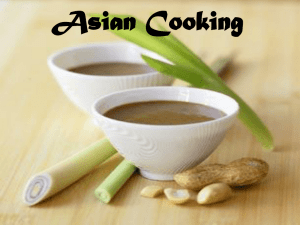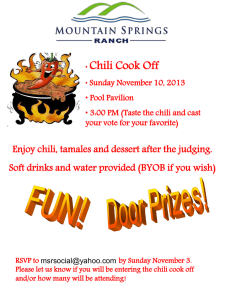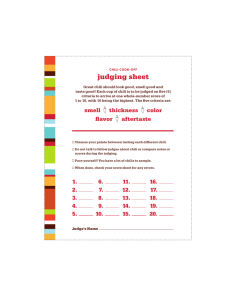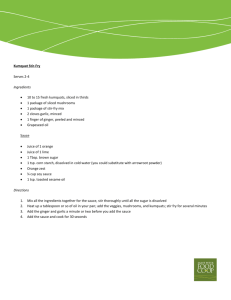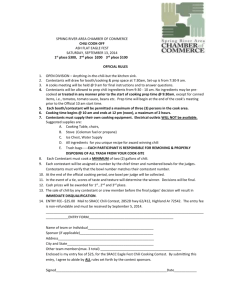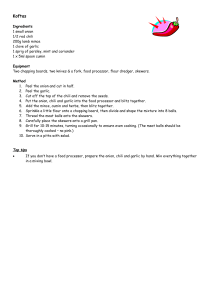Introduction to Chinese Cooking
advertisement
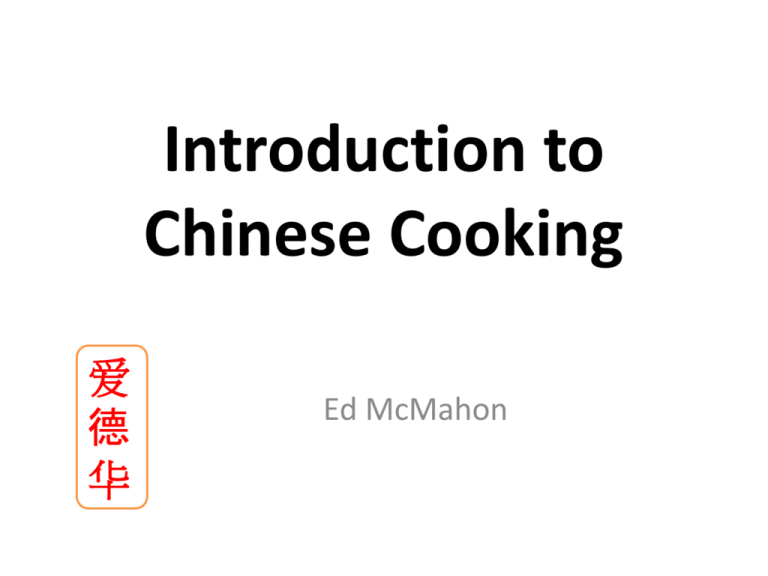
Introduction to Chinese Cooking 爱 德 华 Ed McMahon Egg Rolls, Wontons, Dim Sum • Egg rolls, spring rolls – filled wrappers usually deep fried. Flour and water wrappers, sometimes with egg. 8-10” wrappers • Wontons – filled small wrappers. “Cloud birds”, steamed or fried or in soup • Dim Sum – “Warm heart”. Large variety of small dumplings, balls, shao mai (purses), bao (steamed or baked sweet yeast dough), etc. Shao mai, char siu bao, har gow Sauces for Dim Sum • Soy and rice vinegar (with a pinch of dry mustard, or chili paste, or sesame oil, or sesame chili oil) • Ketchup, hoisin and sesame chili oil • Hoisin, soy and sesame oil (and sugar) • Chili paste, soy and sesame oil • Soy and mustard (and garlic) • Soy, ginger, sugar and vinegar Cooking Tools • Wok – – – – • • • • • Carbon steel preferred Flat bottom for electric stoves Use a wok ring for stability on gas stoves Don’t get a non-stick wok! Spatula Ladle Strainer Steamer Cleaver – carbon steel best Seasoning the Wok • Thoroughly scour the wok with soap to remove protective manufacturing and shipping oils • Dry, and over high heat, heat the wok until it discolors all over (blue or tan), then add oil (it will smoke) and over medium high heat, cook shreds of Chinese chives (about ½ C) until totally charred. Push the chives up and into the sides of the pan. Use enough oil to prevent sticking, and keep just at the smoking point. • Wipe clean Cleaning the Wok • Use the bamboo brush under running water to push any remnants out of the wok. A Scotch-Brite sponge also works. • Dry and lightly oil if necessary. • Do not scour or use detergents. Cleaver • Usually the only knife in a Chinese kitchen • Carbon steel is better than stainless – Takes a sharper edge, but doesn't keep it as long as stainless – Will rust if not kept dry – Discolors from food acids • Keep sharp with sharpening stone – check edge in bright light • Back used to pound meat; handle used to crush garlic, peppercorns; flat used to smash garlic, ginger; blade used to scoop and carry items Yunnan Clay Pot Chopsticks • There is one fixed stick and one that moves • The fixed stick is held by the web at the base of the thumb and rests on the bent fourth finger. • The moving stick is held just like a pencil – Thumb presses it against the 2nd and 3rd fingers – Motion is mostly by the 2nd and 3rd fingers • Adjust so the tips of the sticks touch Chicken Stock • • • • 1 stewing chicken 4 slices of ginger root 1 green onion 2 tsp salt • Cut the chicken into parts. Put the parts (with skin on) in the pot and cover with water (about 8 Cups). Mince the ginger and slice the green onion into 1” pieces. Add the ginger, onion and salt to the water. Cover and bring to a boil, then skim the surface of the liquid. Recover, and simmer for 1 to 1 ½ hours. Remove the chicken parts, and save the meat for another dish. Skim the surface. Strain the soup and refrigerate. When cold, remove most of the fat from the broth. Egg Drop Soup • • • • • 4 C. of the above chicken stock 2 Tbs cornstarch dissolved in ¼ C. of cold water 2 eggs, beaten in a bowl 1 green onion cut into 1/8 inch slices 2 tsp. sesame oil • Bring the stock to the boil, and slowly stir in the cornstarch mixture until it is incorporated, and the soup thickens. While stirring the soup over heat, drizzle the beaten eggs down a pair of chopsticks into the side of the soup where the eggs will be caught in the swirl. Remove immediately from the heat and add the onions and sesame oil. Serve. Yin and Yang Cooking Yin Qualities: Boiling Poaching Steaming Yang Qualities: Deep-frying Roasting Stir-frying Techniques • Preparation vs. cooking –Preparation can be 30 to 60 minutes • Slicing and marinating meat • Cutting vegetables and aromatics • Mixing sauces –Cooking can be 4 to 6 minutes for stir fry Uniform size and shape • Need for uniformity and appropriate size and shape of components – Vegetables and meat should be equally sized and shaped – Bite sized – Shredded and julienned or thin slices or equal small cubes Preparation of Meats and Seafood • Marinating – Common for beef, chicken, pork and shrimp – Rice wine, cornstarch, soy sauce • Velveting – Frying beef, lamb or chicken in 1” of 350 deg oil for 10 to 15 seconds to tenderize and soften the surface against any toughness from stir-frying • Deep Frying – Marinated pieces are coated with flour and cornstarch or an egg batter and deep fried – Shrimp, whole fish, pork, beef • Steaming – Whole fish, spare ribs Other cooking methods • Red Cooking – braising. Two tablespoons of oil, green onion, ginger and meat cubes, stir fry. Add soy, honey, wine, water, ½ tsp five spice powder. Cover and simmer for 25 minutes • Roasting – marinate in hoisin sauce, wine, honey, soy, garlic, ginger, green onion. Hang over charcoal fire. Same as traditional barbeque. Other Szechwan Cooking Styles • Con-shao – “cooked dry” – stir fry with ginger, garlic, hot bean sauce, wine. Add stock, cook until almost dry. Lastly, add sugar, vinegar, ketchup, green onion garnish. Thicken with cornstarch. • Yu-Xiang – “fish fragrance” – garlic, ginger, green onion, flower pepper. Add chili sauce, red chili, hot bean sauce, sugar, vinegar, wine, cornstarch. • Ma-la – “sesame hot” – chili sauce, chili oil, flower pepper, soy, sugar, salt, green onion, ginger. • Suan-la – “hot and sour” – flower pepper, chili oil, vinegar, plus soy, salt, sugar. More Szechwan Styles • Con-chao – “dry-fried”- very little oil, chili, flower pepper, hot bean sauce, sugar, wine, salt, garlic, green onion. No water or stock. • Guai-wei – “strange taste” – sauce with all five flavors: sweet, sour, hot, salty, sesame • Chao-ma – pepper and sesame sauce mixed with flower pepper, sesame oil, salt, soy, vinegar, sugar, minced ginger and green onion. • Hong-you – “red oil” – Sichuan spiced chili oil Stir Frying • Oil is added to a hot pan. When oil is hot, add aromatics – seasons the oil • Then add components – Different components require different cooking times • Meats, fish, usually next, then sauce, then veggies and accents. (Deep fried meats or shrimp added last.) – Sometimes stock then cornstarch paste is added at the end. – Some veggies must be pre-cooked (blanched) Stir frying technique • Retaining colors and flavors is important – Don’t overcook • Constant stirring and folding • Judgment is required to know when to add and how long to cook • All ingredients must be at hand, and properly prepared Oil • Peanut oil or other high temperature oil should be used. (450 deg smoke point) • Corn, sunflower, safflower oils are also good. • Canola (rapeseed) is ok (400 deg smoke point) • Avoid olive oil, margarine and butter • Spatter is a problem, and is unavoidable when cooking with hot oil. Be careful! Cooktop Burners • Electric ranges – 6000-7000 BTU/hr (Power) – 1 watt = 3.4 BTU/hr (6800 BTU/hr = 2kW) – Power is energy per unit time; BTU is an energy unit Residential gas stoves – 7000 – 9000 BTU/hr Gourmet home stoves – 8000 – 18,000 BTU/hr Standard restaurant burner – 32,000 BTU/hr Specialized wok cooktops (Viking, others) – 25,000 30,000 BTU/hr • Outside wok gas burners – 30,000 – 100,000 BTU/hr • Chinese restaurant stoves –100,000+ BTU/hr • Good ventilation is absolutely critical • • • • Outdoor Propane Burner Available from Importfood.com $175 100,000 BTU/hr A little physics • 1 calorie is the heat (energy) required to raise 1 gram of water (1 mL, 1 cc) one degree Celsius. (1tsp=5mL) – (One “food calorie” is really 1 Kcal = 1000 calories) • 100 calories raises 1g water from 0 deg C to 100 deg C. • It takes another 780 calories to vaporize (boil) that 1g of water. The latent heat of vaporization. • 1g steam is 1700 times the volume of 1g water • 1 British Thermal Unit (252 cal) is the energy to raise 1 lb (mass) of water (about 1 pint) one deg Fahrenheit • 970 BTU/lb is the latent heat of vaporization The need for heat • When deep frying (350 to 400 deg F) the hot oil seals the food, but the water is boiled (212 deg F) out of the food (is dehydrated). The steam exiting the food stops the food from absorbing the oil. If the mass of the food is too much, the temperature of the oil will drop, not enough steam will be produced quickly enough, and the food will absorb too much oil. • Similar things happen when stir frying, but the mass of the oil is missing. Therefore, very high heat is needed to keep the temperature of the wok (and oil) high. • Safety must be paramount – ventilation, fire protection and spatter protection are necessary. Color Temperatures Flame Temperature Material burned Charcoal fire Methane (natural gas) Bunsen burner flame Propane blowtorch Candle flame Backdraft flame peak Magnesium Hydrogen torch MAPP gas Acetylene Oxyacetylene Flame temperature (°C) 750–1,200 900–1,500 900–1,600 1,200–1,700 ~1,100 (majority) 1,700–1,950 1,900–2,300 Up to ~2,000 2,020 Up to ~2,300 Up to 3,300 (°F) 1380-2190 1650-2730 1650-2910 2190-3090 2010 3090-3540 3450-4170 3630 3670 4170 5970 Interesting Temperatures Deg F 0 32 40 65 98 125-130 160 212 280-330 350-400 450 600 750-800 1275 1650-2700 Activity Freezer temperature Water freezes Refrigerator temperature Room temperature Body temperature Rare beef Well-done beef (USDA for ground) Water boils Maillard reaction (browning) Deep frying Peanut oil smoke point Average cooking oil flash point Auto-ignition point for cooking oils “Red hot” electrical burner Natural gas flame (methane) Chinese Restaurant Stove • Steel with ceramic rings to hold the wok. • Rimmed stove; whole top is drained, water used to rinse wok is dumped on the stove. • Gas is controlled by a knee switch • Pots of oil, chicken stock, sauces sit on stove top • Articulated water spigot over stove • https://www.youtube.com/watch?v=cGEHcGVYzmw • https://www.youtube.com/watch?v=fMKSNMd0tn4 The Breath of the Wok • A well-seasoned wok used to stir fry a dish over high heat can produce a flavor called wok hay in Cantonese (wok chi in Mandarin), translated as “the breath of the wok” • It is an elusive, subtle, slightly smoky taste of “heat” that is the goal of Cantonese stir fry chefs.
